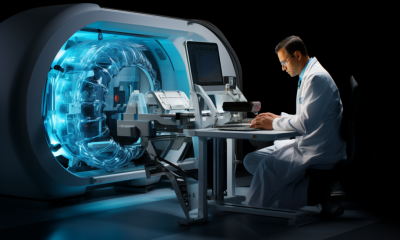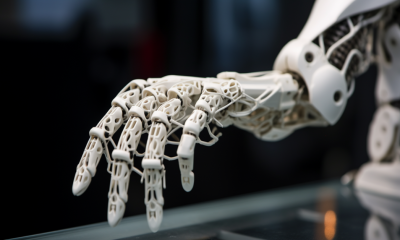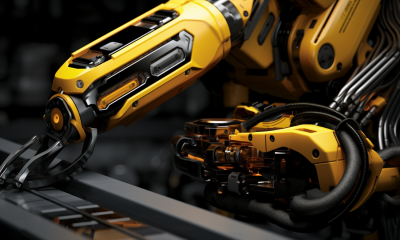Additive Manufacturing
Liquid Metal Printing May Become a ‘Productive Force in the Landscape of Manufacturing and Design’
Securities.io is not an investment adviser, and this does not constitute investment advice, financial advice, or trading advice. Securities.io does not recommend that any security should be bought, sold, or held by you. Conduct your own due diligence and consult a financial adviser before making any investment decisions.

Additive manufacturing – commonly referred to as 3D printing – has long been a tantalizing technology due to its potential for forwarding so many industries (e.g., semiconductors, scientific equipment, housing, etc.). This potential has finally reached a tipping point in the last few years as it transitions into reality. The latest example of this comes from the Massachusetts Institute of Technology (MIT), where a team of researchers has recently unveiled a new additive manufacturing technique called Liquid Metal Printing (LMP).
What is Liquid Metal Printing?
This new technique, Liquid Metal Printing (LMP), is a specific type of additive manufacturing involving molten metal. This process involves,
- Create a pre-defined toolpath.
- Heating and maintaining a metal, such as aluminum, to a temperature just above its melting point within a furnace-powered crucible.
- Dispensing molten metal along the toolpath through a gravity-fed controllable nozzle connected to the crucible.
It is important to note that the team of researchers behind this technique acknowledges that “Liquid metal printing is conceptually similar to free-form-casting, where a large amount of metal is melted and rapidly dispensed along a predefined toolpath in order to produce a 3D form.” The difference is that this process is quicker, provides a much higher degree of control, and allows for more complex shapes and structures to be made.
Is There a Need?
Plenty of novel approaches to existing processes and techniques in industry are constantly being developed. However, not all have a reason good enough for adoption. With LMP, the team of researchers behind its refinement believe otherwise. First, they clearly identify a lingering issue.
“the current state of metal additive techniques comes with significant processing cost, reduced production rates, and build environments that are challenging to scale”
Keeping those limitations in mind, the team believes that LMP can address each.
“To overcome the present limitations amongst the raft of metal additive techniques, we propose LMP, a scalable and cost-effective technology to rapidly print structural components. Liquid metal printing offers a new paradigm of metal printing in architecture by shifting from small, slow, and fine resolution components, to large, fast, and medium resolution structural members.”
If correct in their belief for LMP to address lingering issues involving metal additive techniques, the team envisions a future in which scrap aluminum can be given a purpose, as it will be melted down and used to print components for large-scale structures.
Top Potential Beneficiaries of Liquid Metal Printing (LMP)
Additive manufacturing has evolved by leaps and bounds over the past few years. LMP now represents a viable path forward for leveraging technology on a larger scale and by different industries (i.e., Aerospace). While none of the companies listed below have formally adopted LMP, each boasts Aerospace divisions that could benefit from such an approach one day.
*Figures provided below were accurate at the time of writing and are subject to change. Any potential investor should verify metrics*
1. General Electric
General Electric Company (GE +1.73%)
General Electric Company (GE +1.73%)
| Marketcap | Forward P/E 1 Yr. | Earnings Per Share (EPS) |
| 143,279,056,890 | 28.81 | $8.37 |
The integration of Liquid Metal Printing (LMP) technology presents a significant opportunity for advancement in manufacturing efficiency and innovation, particularly in GE's Aviation and Power sectors.
By adopting LMP, GE could revolutionize the production of complex metal components, leading to potential cost reductions and accelerated production timelines. This could be especially beneficial in the production of jet engine parts, where LMP's capability to rapidly prototype and produce high-quality, intricate metal parts aligns well with GE's commitment to leading-edge technology and efficiency in aerospace manufacturing.
2. Boeing
The Boeing Company (BA +2.98%)
The Boeing Company (BA +2.98%)
| Marketcap | Forward P/E 1 Yr. | Earnings Per Share (EPS) |
| 123,820,601,042 | -33.70 | $-4.70 |
Investors looking at the future of aerospace manufacturing should recognize LMP's ability to create complex, lightweight metal structures. Like General Electric, its adoption could rapidly transform Boeing's production process – particularly in manufacturing aircraft components where weight and strength are critical factors.
This advancement would not only streamline Boeing's such processes but also potentially lead to the development of more efficient and environmentally friendly aircraft, aligning with the growing demand for sustainable aviation solutions.
3. Honeywell International Inc.
Honeywell International Inc. (HON +0.44%)
Honeywell International Inc. (HON +0.44%)
| Marketcap | Forward P/E 1 Yr. | Earnings Per Share (EPS) |
| 133,082,927,504 | 22.11 | $8.07 |
For Honeywell International, incorporating LMP technology into its manufacturing repertoire could yield significant benefits, particularly in its aerospace division and performance materials sector. The adoption of LMP could lead to more efficient production processes for aerospace components, enhancing Honeywell's competitiveness in this market alongside others like General Electric and Boeing.
Additionally, in the performance materials sector, LMP's precision and efficiency in metal printing could facilitate the development of innovative products, aligning with Honeywell's strategic focus on technological leadership and market differentiation. If the process were adopted, it could present a compelling opportunity for investors interested in a company at the forefront of industrial innovation.
Final Thoughts
Additive manufacturing has proven that it is here to stay, and techniques like LMP are poised to open up new avenues for utilization. To sum things up, the team of researchers behind LMP say it best.
“In conclusion, we demonstrate that LMP holds the potential to become a productive force in the landscape of manufacturing and design, both as a tool for prototyping, and as a form of rapid, low-cost, large-scale, circular production.”











